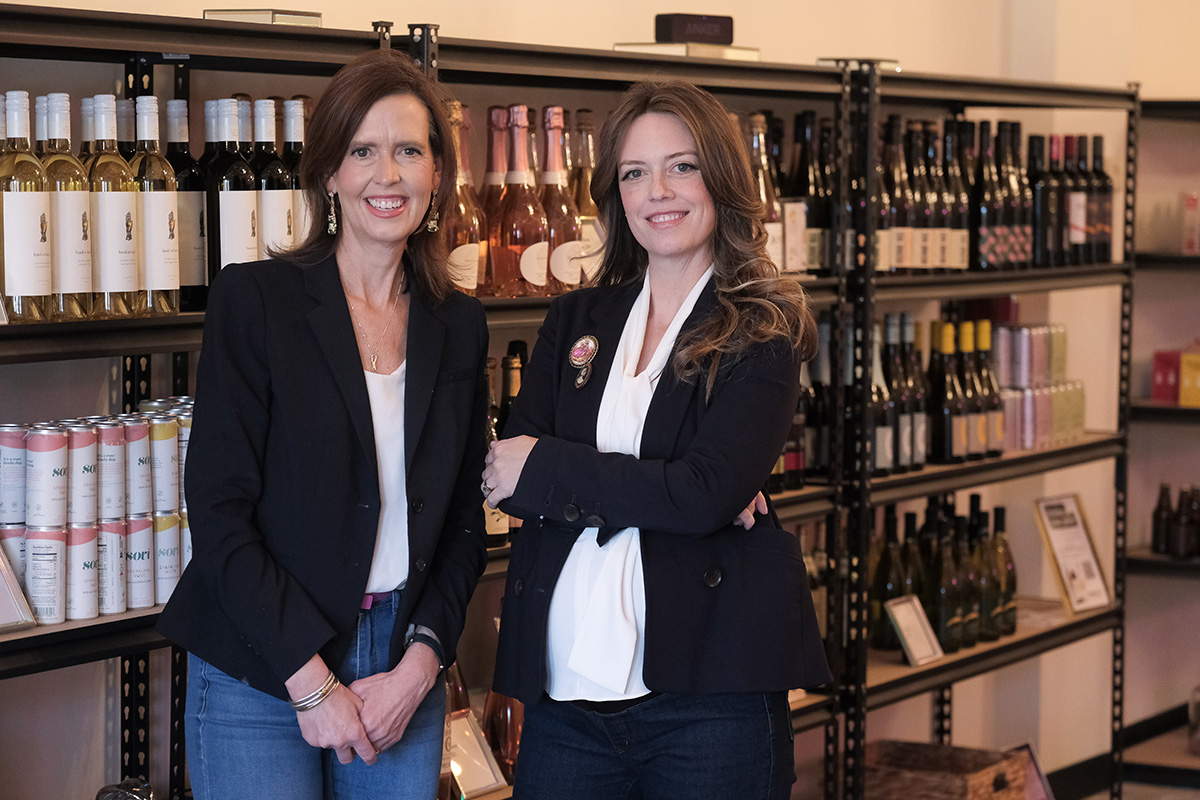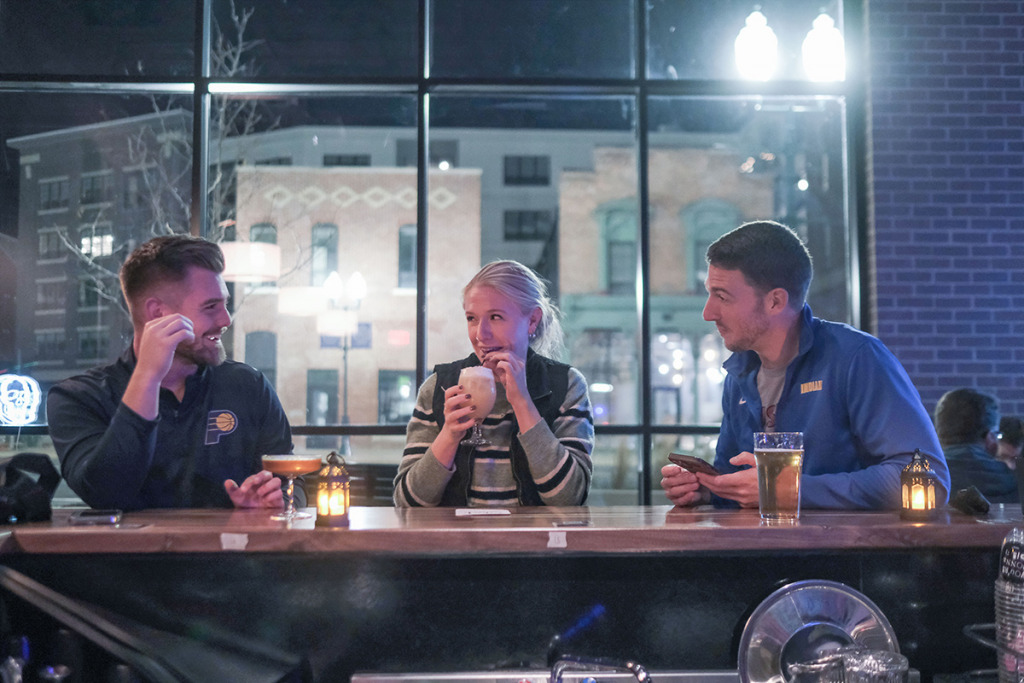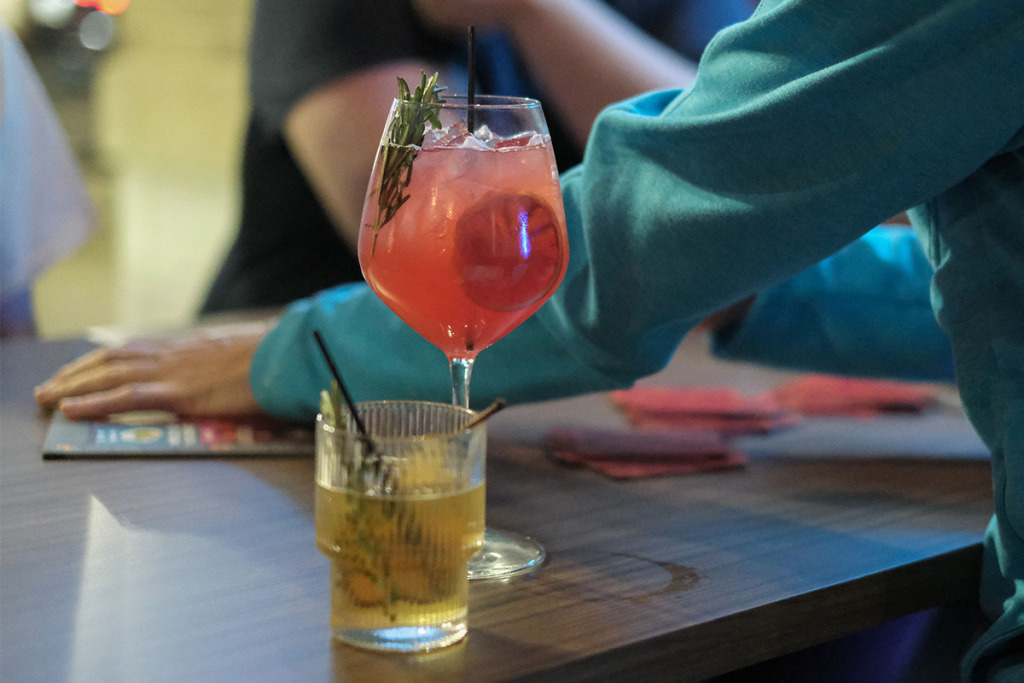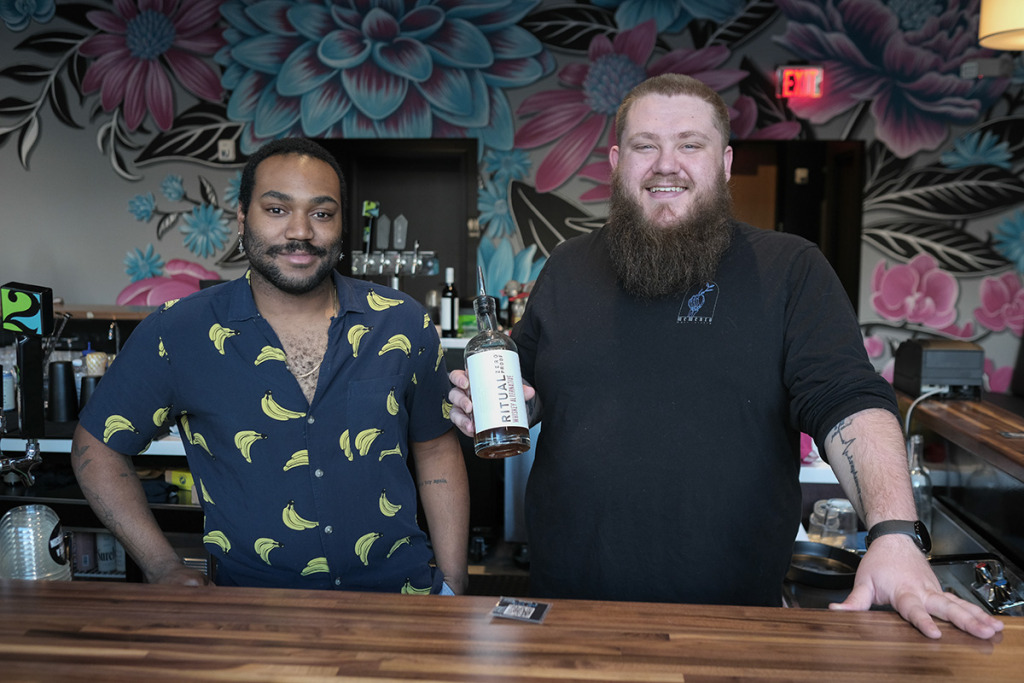Subscriber Benefit
As a subscriber you can listen to articles at work, in the car, or while you work out. Subscribe NowMemento Zero Proof Lounge in the Fishers Nickel Plate District looks and sounds like any other bar. Friends sit together, laughing and talking while enjoying a drink as music plays over the sound system.
There’s one big difference—all the drinks on the menu, from beers to cocktails, are nonalcoholic.
Memento, which opened last month in the First Internet Bank building at 8701 E. 116th St., is the brainchild of Max Gavin, 24, and Shwa Hall, 25.
“We say it’s a pressure-free environment,” Hall said. “We serve people who are in recovery, people who are pregnant, people who are religious and don’t want to drink, people who just don’t want to be around [drunk people] because they’re annoying. We don’t judge. We just welcome everybody.”
Memento’s opening comes as sales and interest in nonalcoholic drinks are increasing.
According to Chicago-based consumer researcher NielsenIQ, total dollar sales of nonalcoholic drinks from August 2022 to August 2023 in the United States in off-premise locations, such as grocery and liquor stores, was $510 million. While that represented a small drop in the glass of drink sales, it marked a year-on-year growth of nearly 31%.
Increased interest from major beverage companies was put on display in February when Heineken USA purchased the first-ever Super Bowl commercial for a nonalcoholic beer, with actor Paul Rudd pitching the beverage.
While some area bars and breweries, such as Hotel Indy’s CannonBall Lounge and Sun King Brewing, offer nonalcoholic drinks, Memento is the first fully sober bar to hit the Indianapolis area.
Booze-free bars and nonalcoholic retail bottle shops are found mostly on the coasts, though a handful have taken root in the Midwest. Bendicion Dry Bar and Prazbar, both in Chicago, are nonalcoholic bottle shops. Inmoxicated in suburban Milwaukee is a sober bar, and Sans Bar STL in St. Louis hosts nonalcoholic, pop-up events.
Brewers have several options for removing alcohol from beer; distillers separate the ethanol in liquors through reverse distillation after natural or accelerated barrel aging.
Gavin said Memento’s primary customer base so far has been people in their 30s and 40s who are interested in healthy living and wellness and want to eliminate at least some alcohol from their diets.
“A lot of people in this millennial crowd are just starting to realize they can have fun without alcohol and that it actually doesn’t make them feel great, especially afterwards,” Gavin said.
Gavin and Hall have been friends since elementary school. As Fishers High School students, they opened the Stonetree recording studio in Fountain Square. The idea for a nonalcoholic bar came to them six years ago when they grew tired of having nowhere to go in the evenings after coffee shops closed for the night.
“I grew increasingly frustrated with the fact that there was just nowhere for us to go after that because we were too young for the bars but yet too old for kids’ spaces,” Hall said.
Gavin and Hall spent two years planning Memento’s opening. They began with a pop-up concept in early 2021 and provided drinks at vendor and private events, which helped them gain funds and test the market for nonalcoholic drinks.
To open Memento, Gavin and Hall spent about $300,000, which they raised through a Kickstarter campaign, events, personal funds and working multiple jobs. Gavin managed a vape shop, while Hall worked as a barista and delivered flowers.
Their drink menu includes nonalcoholic beers, wines, cocktails, liquor, absinthe, amaretto and whiskey. They also sell specialty coffees and food, such as paninis and yogurt bowls.
Changing habits
Sitting at a table at Memento, Trey and Arianna Carlisle attributed changing drinking habits for millennials and Generation Z to a desire for a healthy lifestyle and a history of watching older family members struggle with alcohol. (Millennials are generally considered people born from 1981 to 1996, and Gen Z represents those born from 1997 to about 2010.)
“For me, something that has kind of changed how I go out [and] what I do on the weekend is, my grandpa was a heavy drinker,” said Trey Carlisle, 25.
Arianna Carlisle, 30, added that being hungover after a night of drinking does not appeal to her.
“That has been a big part of why I don’t drink as much anymore,” she said. “First of all, I don’t like how I feel, and the second is that it’s not aligned with my healthy lifestyle.”
Julia Chester, a professor in Purdue University’s Department of Psychological Studies, studies alcohol-use disorders. She said a generational shift in drinking habits is underway as millennials and Gen Zers forswear or cut back on alcohol in greater numbers than did previous generations. Generation X, which comprises people born from about 1965 to 1980, began drinking early and continued far into adulthood, she said.
“What we’re seeing now is the consequences of that,” Chester said. “As a cohort of more people drink, the more that carries forward into consumption over their lifetime.”
Chester compared the effort to educate people on the dangers of alcoholism—dating back to the campaign beginning in the 1980s by Mothers Against Drunk Driving to stigmatize drunken driving—with the campaign against smoking.
About 140,000 people die each year in the United States from alcohol-related problems, according to the National Institute on Alcohol Abuse and Alcoholism. It’s the fourth-leading preventable cause of death in this country behind tobacco, poor diet and physical inactivity.
“This is something that the government and educators have been working on for a long time—to educate people about the ill effects and the health-related risks of drinking alcohol, and we’re starting to see the fruits of that labor now in these younger generations,” Chester said. “Part of what’s driving this lower intake in these generations is that they haven’t gotten started with their drinking in the first place.”
According to Gallup, among U.S. 18- to 34-year-olds, 62% of respondents described themselves as drinkers rather than abstainers. That percentage was 72% in 2003.
Conversely, the poll indicated that people age 55 and over who described themselves as drinkers increased from 49% in 2003 to 59% now. People age 35 to 54 remained consistent at a drinking rate of 67% now versus 69% in 2003.
Gavin said his family has a deep history with alcoholism. The day he stopped drinking four years ago was the day he lost his uncle—whom he called his closest family member—to complications with alcoholism.
“Seeing him go through all those problems over the last decade and dealing with all the medical stuff, I just decided, ‘I think, before it becomes a problem, I’ll go ahead and cut it out of my life.’ That way I never have to deal with those issues and never have to see my family deal with me going through those issues,” he said.
Hall added that, while he is not a teetotaler, he drinks rarely. He adopted the lifestyle change after he got married, had his first child and began “thinking about longevity.”
“As soon as I discovered [the nonalcoholic beer company] Athletic Brewing and some of the other beers, I pretty much stopped buying regular beer because it tastes the same, and I drink it for the taste,” Hall said.
Social media, something older generations didn’t grow up with, also plays a role in the lack of enthusiasm for drinking for millennials and Gen Z, Chester said.
“That cultural aspect is huge in terms of shaping perception,” she said. “A lot of what drives human behavior is the social influence. ‘How do my friends view me? What are my friends doing? What are my friends going to think of me if they see me doing this?’ And that has really powerful influence on people’s attitudes and beliefs, and then, consequentially, what they will be consuming and not consuming.”

New venture
It’s not just millennials and Gen Z who are thinking more about their drinking habits.
Sisters Andrea Simpson and Kristin Patrick, both in their 40s, developed an idea for a nonalcoholic bottle shop—Loren’s AF Beverages—in the midst of the pandemic when they quit drinking alcohol.
“Like many of our clientele, we just found that we weren’t bouncing back like we used to with drinking,” Simpson said. “Eliminating it was totally transformational for both of us.”
Simpson said she read about the rise of the booze-free bottle shop in the January 2022 issue of Vogue Magazine, and the idea stuck. That summer, Simpson and Patrick opened their first two Loren’s AF Beverages locations, one on the east side of Carmel and the other in The Village of West Clay. They also distribute products wholesale to bars, restaurants and coffee shops.
Loren’s AF Beverages—named for the sisters’ late father—sells wines, beers, spirits, seltzers and drinks with adaptogens (herbs, roots and other plant substances that help bodies manage stress) and supplements. The business is the second nonalcoholic bottle shop in Indiana after Generation NA, which also opened in 2022, in Lafayette, and focuses on beer sales.
Simpson said it seemed like a risk to operate a nonalcoholic bottle shop in the Midwest when most stores are on the East Coast from New York to Charleston, South Carolina, “but from Day 1, it really was quite successful.” She and her sister are now looking at the possibility of opening more locations next year and offering franchising opportunities.
Simpson said the majority of her customers, who tend to be women ages 35 and up, are not people in recovery or who don’t drink at all. Rather, they are people who still drink and are looking for ways to cut back.
She tells them there is no wrong way to do that. One option she sometimes advises is to start with a traditional drink, then the “second or third drink is [nonalcoholic] or zero-proof.”
“This is growing into a multibillion-dollar global market with no signs of slowing,” Simpson said. “I think young people are probably at the beginning of the bell curve. We’re catching the women that are really curious and concerned about well-being and health. I think we’re going to capture a lot more of the men in the future, and I think these products are just going to get better.”•
Please enable JavaScript to view this content.





